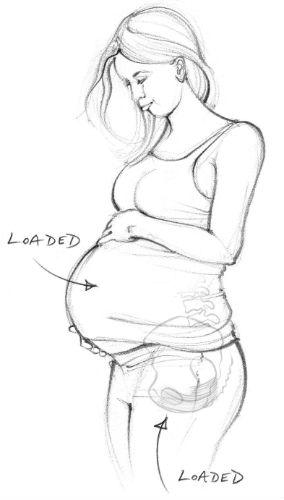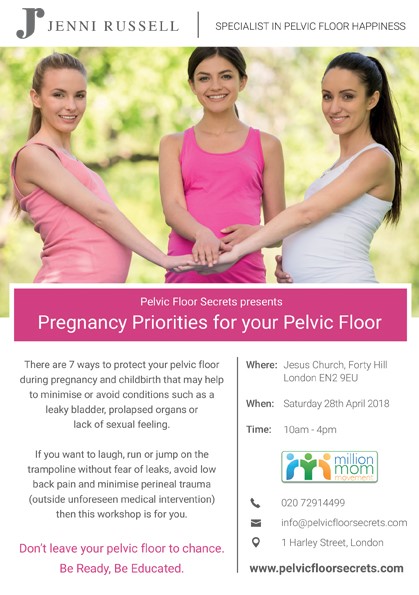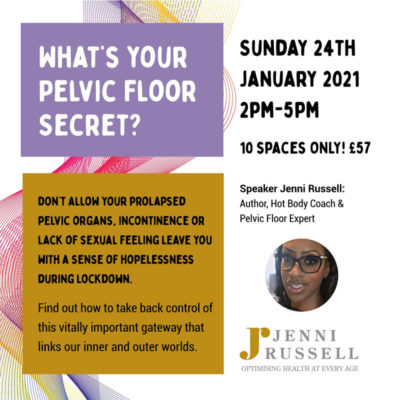BLOG
Jenni Russell’s latest news and information
7 ways to protect your pelvic floor in pregnancy
There is nothing more exciting for most women than bringing a new life into the world. The excitement that comes with the expectation of having either a boy or a girl and all the beauty of planning the room and accessories become a focal point especially in the last trimester.
But one area of the body that is continuously overlooked during this amazing period is the pelvic floor muscles. Those hidden muscles that have to carry the weight of the growing baby, alongside the uterine sac and a colon that usually becomes compacted as it has less room to move and flow.
If you want to enjoy your pregnancy with minimal or no leaking and have a good childbirth experience (outside unplanned medical intervention) then to return to intimacy with confidence, run laugh and jump on the trampoline at the right time then these 7 things can help you protect these vitally important muscles that link your inner and outer worlds, your gateway to pelvic floor and your health and happiness:
- Posture first – In the first three months of the pregnancy the baby lives within the pelvic cavity before it moves up into the abdominal cavity. It would be wise to pay attention to and include simple postural exercises that will protect the lower abdominal and low back. The baby already alters the position of pelvis, don’t add to that by continually wearing high heels. Try to stay neutral to avoid adding additional stress to your ligaments or additional shortening and tightening to the muscles around the hip and pelvis. This will help minimise or avoid low back pain and/or sciatica. Choose exercises that promote good posture. A Swiss ball makes for a great posture friendly seat as well as an aid for labour.
- Breath – your diaphragm is the biggest biological pump in your body. When it is working properly it creates major pressure fluctuations within the abdominal cavity and this pressure ultimately impacts the pelvic floor. It also helps the internal organs to maintain their motility (natural rocking action) whilst fighting for space with the baby. As the baby moves into the abdominal cavity and pushes the organs higher up, or lower down, its movement may become shallower and as the abdominal wall becomes inhibited with the baby behind it, the pelvic floor is exposed to increased load and may become weak. Try and include diaphragmatic breathing in your daily exercise routine to optimise your oxygen flow and protect your pelvic floor.
 Protect your abdominals – your posture, breathing, exercise choice and digestion all have a direct impact on your abdominal wall’s ability to support the internal organs, avoid hernia, distension and even prolapsed organs. This may expose the abdominal wall to weakness and separation – also known as diastasis recti. When digestion is sluggish and one does exercises that create increased pressure within the abdominal cavity such as hundred’s in Pilates, crunches and the plank for example, the head is pulled forward and down and the respiratory diaphragm, abdominal wall and pelvic floor can no longer work effectively.
Protect your abdominals – your posture, breathing, exercise choice and digestion all have a direct impact on your abdominal wall’s ability to support the internal organs, avoid hernia, distension and even prolapsed organs. This may expose the abdominal wall to weakness and separation – also known as diastasis recti. When digestion is sluggish and one does exercises that create increased pressure within the abdominal cavity such as hundred’s in Pilates, crunches and the plank for example, the head is pulled forward and down and the respiratory diaphragm, abdominal wall and pelvic floor can no longer work effectively.- Digestion is key – The organs have to fight for space as the uterine sac grows with the baby. The stomach is no different. In order to avoid poor digestion and a sluggish gut that is uncomfortable, it is wise to drink a full glass of water 1/2hr before eating and get excited about your food to create a phallic response. Eat your food in a calm environment (not in front of the tv or smartphone) otherwise you will divert the oxygen away from the stomach up to the eyes thus slowing down digestion. Also, if you drink as you eat you slow down digestion – both of these can cause discomfort as food sits, rather than being digested. Remember the stomach is an organ being squashed as space is sacrificed for the growing baby.
- Empty a “full” bladder – because the bladder lives just behind the pubic bone, it is prone to increased pressure as the uterus (its shield in everyday life) moves above it in pregnancy and presses against it as the baby grows and the pelvis tips forward. Try not to urinate at every twinge as this can weaken the sphincter loops and the pelvic floor that control continence. A full bladder should take in excess of 10 seconds to empty. Don’t suppress the urge to go either, but recognise the difference. Also note that clear urine is a good indication your body is hydrated.
- Remain hydrated – keep your organs happy. Water is vital to serve all the needs of the body and the baby. It is never good to allow any cells in the body to become dehydrated especially when a new life is developing within. The water content within the milk that is produced by the mother is vital for the developing foetus. Growth of the foetus depends on water being present.
- Ensure the right salt – processed food and white salt are products that have been heavily manufactured. Use an unbleached unrefined salt – since it is vital to the growth of the muscles, nerves and organs. Putting a good pinch of unbleached sea salt allows you to create the best electrolyte drink. Don’t overdo it but don’t avoid it. It also necessary for regulation of your heartbeat and blood pressure amongst many other things (Your Body’s many cries for water F. Batmanghelidj M.D.)
I pray like myself you have the most amazing pregnancy experience and are able to have an even better life after childbirth free from any dysfunction for your pelvic floor. It is possible to have it all – it just takes a little knowledge and adjustment.
Your pelvic floor will thank you for it.
Be Ready, Be Educated.





